Generally, the best way to improve pump reliability and minimize downtime is through preventive-maintenance programs, failure analyses, and conducting major maintenance during annual shut-downs or process change-overs.
Pump Component MTBF Breakdown
It is important to understand the dependence of a pump’s MTBF on the MTBFs of its components in what is commonly called a “series system.” Major components to consider in the overall pump MTBF rate are: the shaft seal (normally mechanical); pump bearings; coupling to motor; and pump shaft. However, this potential component failure list can be further expanded to include the pump impeller, wearing rings, and casing, plus the piping, baseplate, alignment, and a veritable host of other operational issues that can influence pump reliability.
If any of these components fail, then the pump becomes unserviceable and must be repaired. The pump thus has one overall MTBF, based on the MTBFs of the individual components, as shown in the table. This data should be viewed as “minimum expectations.” As can be seen, the pump component with the shortest typical MTBF rate is the mechanical seal, followed by the ball bearings. The average ANSI pump MTBF is 2.5 years, with a realistic average target of 3.75 years, and excellent target of 4.5 years. A MTBF of 1.5 to 2.0 years would be considered poor performance.
Improving MTBF Rates
So, what can a pump user do to improve the performance of below average or poor MTBF rate pumps? Since many of my Pump Tips columns in WaterWorld over the past nine years have been focused on pump reliability, it seemed that an index of these articles might help pump users improve their pump MTBF rates. Here, I’ve compiled a list of my prior reliability focused columns, sorted by pump component and operation, in order to offer proven MTBF improvement actions.
Improvements That Impact Multiple Components
Since pump flow rate, speed, cavitation and pump material impact many of the pump components, columns covering these topics include:
1. How to Select the Most Reliable Pump for an Application (Feb. 2012)
2. Operating Pumps Close to Best Efficiency Flow Rates Extends Life (Dec. 2007)
3. Centrifugal Pump Flow Operating Regions and Impact on Reliability (Sept. 2016)
4. Back to Basics: Understanding Pump Cavitation and Its Impact on Pump Reliability (Dec. 2015)
5. Avoiding Cavitation Damage Extends Pump Life (Oct. 2007)
6. Sufficient NPSH Margin Important to Pump Reliability (Jan. 2012)
7. Key Considerations to Help Determine Optimum NPSH Margin for Centrifugal Pump Applications (Part 1: Dec. 2012; Part 2: Jan. 2013)
8. Operating Pumps at Slower Speeds Increases Reliability (Apr. 2008)
9. Reduce Pump Costs with Predictive Condition Monitoring, Fault Tolerant Intelligent Drives/Controls (Apr. 2010)
10. Pump Control: Analyzing the Benefits of Intelligent, Fault-Tolerant Variable Speed Drives/Controls (Aug. 2014)
11. Hybrid Control Improves Variable Speed Driven Pump Efficiency, Reliability (Aug. 2008)
12. How Parallel Pumps Can Be Pushed into Damaging Low Flow Pump Internal ‘Suction Recirculation’ (Mar. 2011)
13. Damage Control: Avoiding Destructive Water Hammer Conditions (Apr. 2014)
Upgrades That Improve Shaft Seal Life
Working closely with seal vendors is one of the best ways to ensure optimal seal life. Other useful tips are outlined in the following articles:
1. Back to Basics: Mechanical Seals for Water and Wastewater Pumps (July 2011)
2. Selecting the Right Mechanical Seal Housing Can Increase Seal Life (Oct. 2011)
3. Gas Lubricated Mechanical Seals for Improved Reliability (Sept. 2015)
4. Considering Dynamic Seals to Address Shaft Sealing Problems (May 2010)
Upgrades That Improve Bearing Life
1. Optimizing Bearing Lubrication Can Extend Bearing Life, Reduce Costs (Feb. 2008)
2. Bearing, Lubrication Issues That Can Reduce Life Cycle Costs (Aug. 2010)
3. Bearing Housing Seal Upgrades Can Improve Pump Reliability (May 2011)
4. Bearing Burdens: Reducing Lubrication Contaminants to Improve Bearing Life, Life Cycle Costs (Sept. 2013)
5. Back to Basics: How to Improve Vertical Turbine Pump Reliability Through Optimum Bearing Selection (Dec. 2013)
6. Centrifugal Pump Bearings: Tips for Improving Reliability and Reducing Failure (Sept. 2014)
7. Extend Bearing Life, Reduce Pump Life Cycle Costs with Oil Mist Bearing Lubrication (Mar. 2016)
Upgrades That Improve Coupling Life
1. Benefits, Methods of Proper Pump to Motor Alignment (Sept. 2010)
2. Back to Basics: Pump Coupling Selection (Sept. 2012)
Upgrade Pump Piping
1. Pump Piping Can Impact Reliability (Apr. 2009)
2. Shake, Rattle and Roll: Effects of Acoustical Resonance on Pumps and Piping (Feb. 2013)
3. Tight Tolerances: Pump Piping Nozzle Loads Can Impact Reliability (Apr. 2013)
4. Considerations for Designing Piping Adjacent to a Centrifugal Pump (Oct. 2013)
5. Sump Impact on Pump Reliability (June 2015)
Impeller Erosion
1. Coatings Can Improve Pump Impeller Cavitation Damage Resistance (Apr. 2012)
2. Impact of Component Material Selection on Pump Reliability (Dec. 2014)
Baseplates and Installation
1. Pump Baseplates and Installation Can Impact Pump Reliability (Nov. 2010)
Conclusions
As demonstrated above, there are many issues and components that determine a pump’s MTBF rate, including: pump speed; flow operation within preferred operating region; suction energy; NPSH margin; bearing lubrication; vibration levels; pump piping; materials of construction; bearing types; mechanical seal systems; and mounting systems and alignment. If a pump’s MTBF rate is short, it can be financially advantageous to not simply replace the broken parts in kind but perform a thorough analysis of the problem like a “best-in-class” pump user.
About the Author: Allan R. Budris, P.E., is an independent consulting engineer who specializes in training, failure analysis, troubleshooting, reliability, efficiency audits, and litigation support on pumps and pumping systems. He can be contacted via email at [email protected].
References
1. Bloch, Heinz P. and Allan R. Budris. Pump User’s Handbook, Life Extension, Fourth Edition, The Fairmont Press Inc., 2014.



